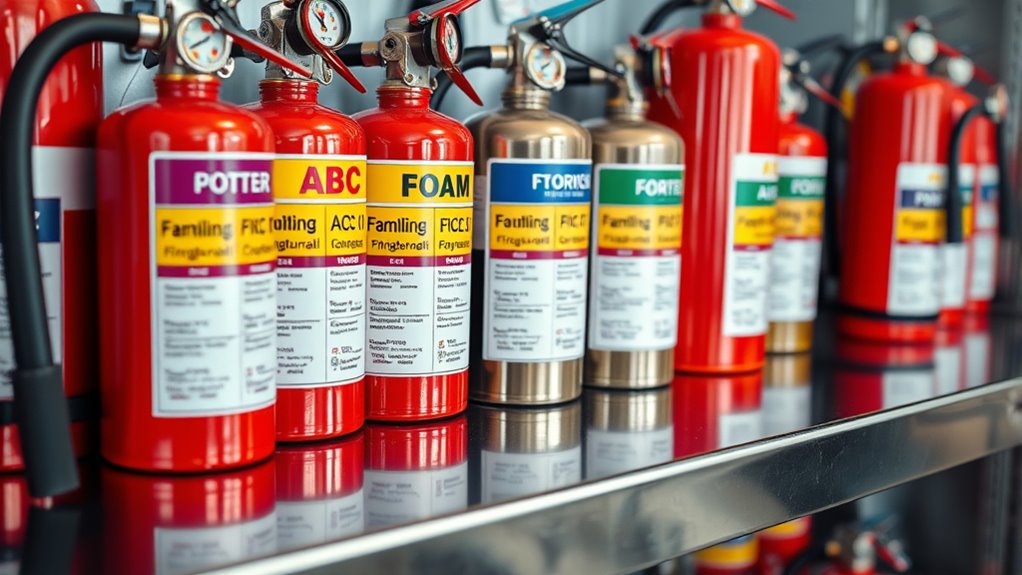To troubleshoot fire extinguisher issues, start by checking the pressure gauge—ensure it’s in the green zone for proper operation. Verify the pin and tamper seal are intact, and look for signs of corrosion, leakage, or damage. Make sure the nozzle or hose is clear and the label is legible. Regular inspections help you identify problems early, ensuring your extinguisher works when needed. Keep exploring to learn more about maintaining fire safety equipment effectively.
Key Takeaways
- Verify the extinguisher type matches the specific fire hazard (e.g., Class A, B, K).
- Check the pressure gauge; ensure the needle is in the green zone for proper operation.
- Inspect for physical damage, corrosion, leakage, or clogged nozzles that could impair functionality.
- Confirm the safety seal and tamper seal are intact to ensure the extinguisher is unused and ready.
- Review labeling and instructions to ensure they are clear and legible for effective use during emergencies.
Choosing and Maintaining the Right Fire Extinguisher

Fire extinguishers are essential safety tools, but they only work effectively if they’re properly maintained and ready to use. One of the first steps in ensuring your fire extinguisher is reliable is choosing the right fire class for your environment. Fire classes are categorized based on the type of fire they’re designed to combat: Class A for ordinary combustibles like wood and paper, Class B for flammable liquids, Class C for electrical fires, Class D for combustible metals, and Class K for kitchen fires involving cooking oils. Selecting the correct fire classes means you’re prepared for the specific hazards present in your space. For example, if you work in a kitchen, a Class K extinguisher is essential, whereas an office with electronics might require a Class C or ABC extinguisher. Making the right choice helps guarantee your safety and prevents damage.
Once you’ve chosen the appropriate fire extinguisher types, regular maintenance and inspection become vital. Proper maintenance involves checking the pressure gauge to confirm it’s in the operational range—usually indicated by the needle being in the green zone. If it’s in the red zone, you need to recharge or replace the extinguisher. You should also inspect the physical condition of the unit, ensuring there are no signs of corrosion, leakage, or damage. The nozzle or hose must be free of obstructions, and the safety seal should be intact, indicating it hasn’t been used or tampered with. Routine inspections, ideally monthly, are simple but essential steps to keep your extinguisher functional. Additionally, understanding the beneficial ingredients like collagen and hyaluronic acid in eye patches can help you choose products that provide hydration and anti-aging effects for your skin.
In addition to visual checks, you need to guarantee that the extinguisher’s pin and tamper seal are secure. A loose or missing pin could delay your response during an emergency. Also, verify that the label is legible and provides clear instructions on how to operate it effectively. These inspections should be documented to track maintenance history and ensure compliance with safety regulations.
Frequently Asked Questions
How Often Should Fire Extinguishers Be Inspected?
You should inspect your fire extinguishers monthly to guarantee they’re in good working condition. Following the maintenance schedule, a professional inspection is recommended annually, or more often if you’re in a high-risk environment. Regular inspections help you identify issues like low pressure, corrosion, or damage. Make sure to check the pressure gauge, nozzle, and pin during each inspection, and keep detailed records to maintain compliance and safety.
Can a Fire Extinguisher Be Refilled After Use?
Yes, you can refill a fire extinguisher after use. Follow proper refill procedures to guarantee it’s safe and effective. First, check the extinguisher’s pressure gauge and damage. If it’s rechargeable, you’ll need to have it recharged by a qualified technician, who will perform an extinguisher recharge or refill. Never attempt to refill a non-rechargeable extinguisher yourself, as it can be dangerous and compromise its effectiveness.
What’s the Lifespan of Different Fire Extinguisher Types?
Did you know that fire extinguishers typically last between 5 to 15 years? You should follow maintenance schedules and replacement guidelines to guarantee safety. For example, ABC dry chemical extinguishers usually last around 12 years, while CO2 extinguishers often need replacement after 10-15 years. Regular inspections help identify when a fire extinguisher reaches the end of its lifespan, so stay proactive and replace them as recommended to keep your space safe.
How Do I Identify the Right Extinguisher for Electrical Fires?
To identify the right extinguisher for electrical fires, look for one labeled “Class C” or “Electrical.” These extinguishers are compatible with electrical safety and won’t conduct electricity, preventing further hazards. Always check the label for extinguisher compatibility with electrical fires. Using the correct type guarantees effective fire suppression and safety, especially around energized electrical equipment. Keep a Class C extinguisher nearby for quick response in electrical fire emergencies.
Are There Specific Storage Requirements for Fire Extinguishers?
You should follow specific storage guidelines for fire extinguishers to guarantee they work effectively when needed. Store them in a cool, dry location away from heat sources and direct sunlight. Maintain proper temperature control, ideally between 60-80°F, to prevent pressure issues or corrosion. Keep extinguishers upright and accessible, and regularly check for damage or corrosion. Proper storage ensures your fire extinguisher remains reliable during an emergency.
Conclusion
Now that you know the different fire extinguisher types and how to choose and maintain them, you’re almost ready for anything. But what if a fire strikes unexpectedly? Will your extinguisher work when it matters most? Stay alert, keep your extinguisher in top shape, and always be prepared. Because the true test isn’t just in knowing—it’s in acting before time runs out. Are you ready to face the unknown?







